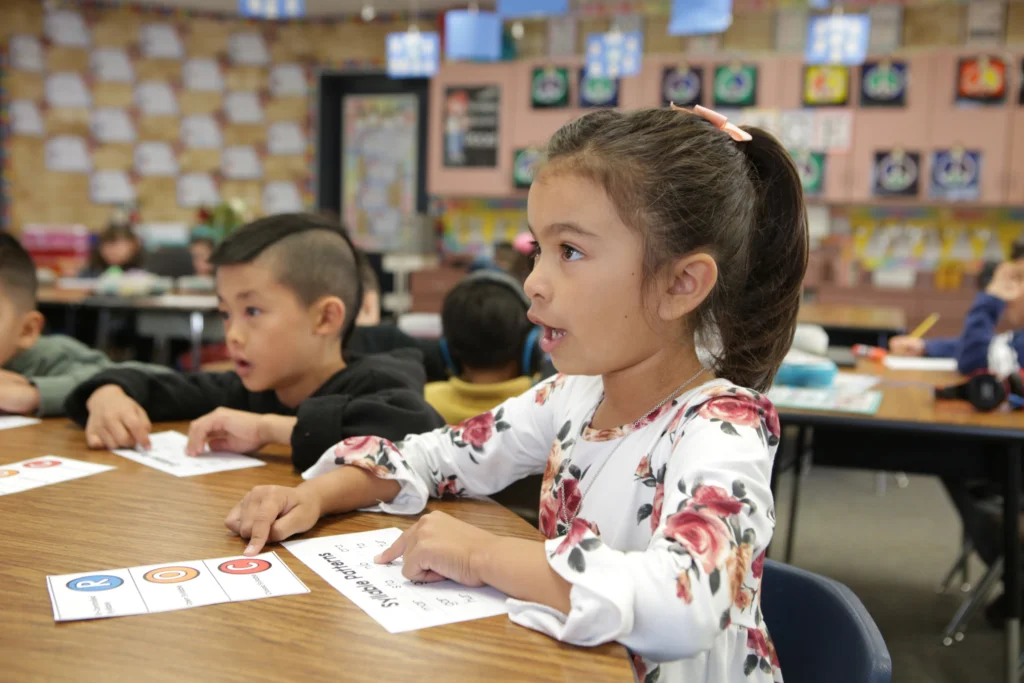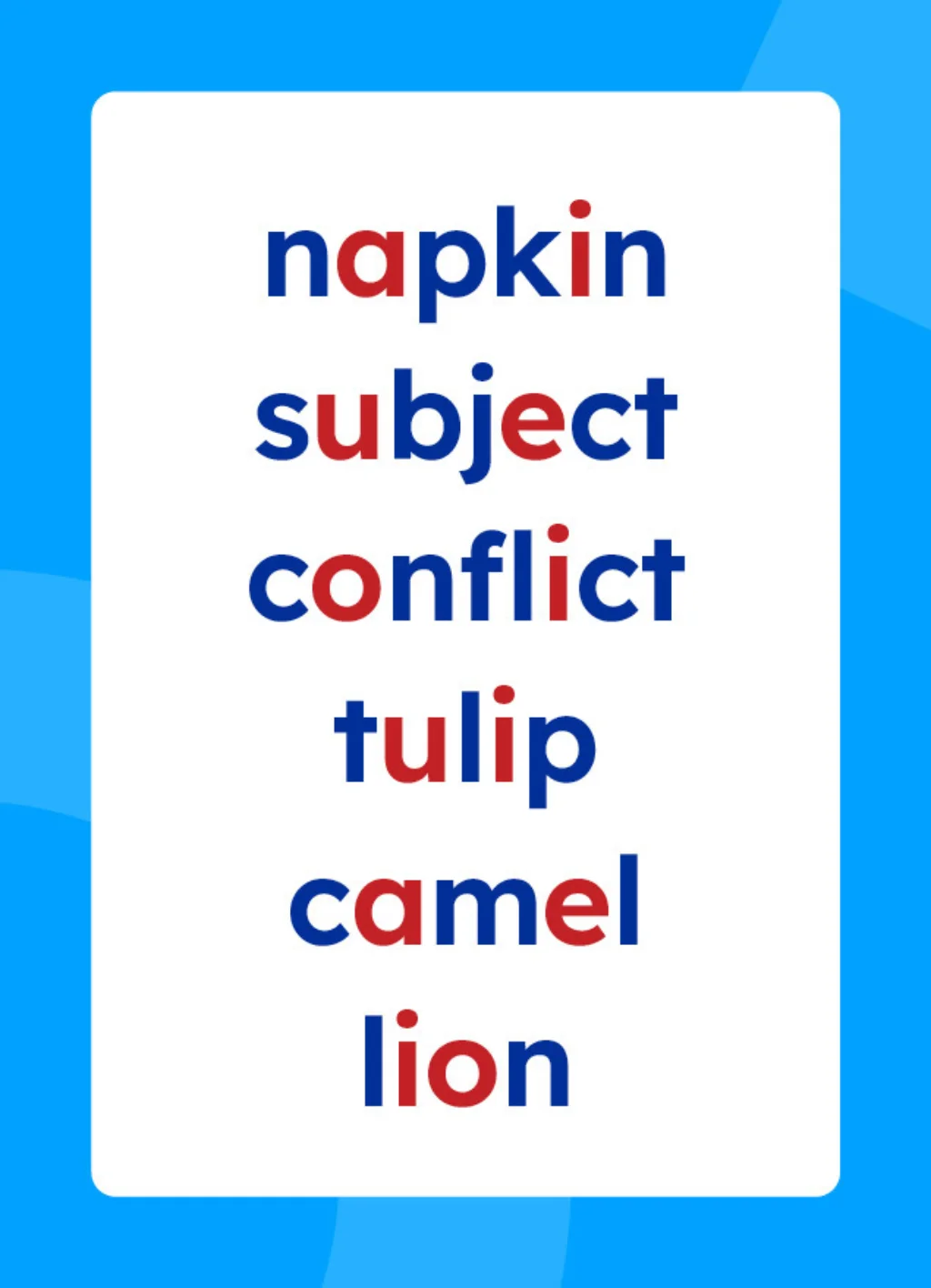1. An Overview of Multisyllabic Words
Multisyllabic Words Skill Explainer
Unlocking Big Words, One Syllable at a Time

As students grow as readers and begin working with more complex texts, they will undoubtedly encounter multisyllabic words … muffin, after, responsible. Did you know that researchers Devin Kearns and Elfrieda Hiebert found that 48% of words in first-grade texts are multisyllabic words? If students don't have strategies to decode these words, they're missing out on almost half of the words they could be reading! In third-grade texts, 65% of the words are multisyllabic.
Just like with decoding one-syllable words, students need explicit instruction in how to decode multisyllabic words. And it's pretty straightforward. They need to be able to:
Divide words into syllables (syllabication)
Decode one-syllable words with different syllable types (open, closed, r-controlled)
Once they're proficient in these two skills, students can use this knowledge to unlock multisyllabic word decoding!

Six Syllable Types
Print this 6 syllable types poster as a reference for you and your students.
Print this 6 syllable types poster as a reference for you and your students.
Chopping Multisyllabic Words
Watch teacher DeAngela Huggins give her students the steps they need to break down multisyllabic words. Using the example word “summit,” Ms. Huggins and her students identify vowels and consonants, label them, and "chop" the word into its two syllables. After they figure out the syllable type (open or closed), students know how to pronounce each syllable (long vowel or short vowel). They read each syllable and then combine them to read the whole word fluently.

Hide Video Transcript
Show Video Transcript
DeAngela Huggins: All right, so we're going to be working with words that have more than one syllable today.
Narrator: In today's lesson, DeAngela Huggins is dividing syllables with her first graders at Burgess-Peterson Academy, or as she calls it, chopping words.
DeAngela Huggins: So we're going to be chopping words today. Big words or words that are multisyllable words. Everyone say multisyllable.
Students: Multisyllable.
DeAngela Huggins: And what that means is, is the word has more than one syllable. So let's review. We're going to review how to chop big words, okay? I have a word. And remember, one thing you have to promise me is that you won't say the word until we're all ready. Even if you know it. Where can you say it?
Students: In your brain.
DeAngela Huggins: In your brain. In your brain.
Narrator: Long words can sometimes trip up young readers. Syllable division helps by breaking these big words into smaller chunks, making reading and spelling easier.
DeAngela Huggins: It's because if we come to a word that has more than one syllable in a book that we're reading, this will actually help us to be able to read the words. So when we chop big words, the first thing I need to look for are my vowels. So I'm going to underline my vowels in my word. And what are my vowels in my word?
Narrator: 'U' and 'i'.
DeAngela Huggins: I'm going to underline my 'u' and my 'i'. Why don't you underline yours in your word too. And because it's a vowel, we're going to label them with a ...
Students: 'V'.
DeAngela Huggins: We're going to label them with a 'v'. All right? Now we're going to label our consonants. And we don't want to label all of the consonants in the word. We just want to label the consonants that are ...
Students: in between the vowels.
DeAngela Huggins: In between our vowels. So Georgia, what are our two consonants in between our vowels?
Georgia: 'M' and 'm'.
DeAngela Huggins: 'M' and 'm'. And so because they're consonants, we're going to label them with the letter. What? Jackson?
Jackson: We're going to label them with the letter 'c'.
DeAngela Huggins: We're going to label them with a 'c'. So everyone that's label our consonants with the letter 'c'. Oh, I have two 'c's in the middle. Do you want to know what I like to call those? I call 'em chocolate chips.
Students: Chocolate chips.
DeAngela Huggins: Very good. And because of chocolate chips, when I chop my word, I'm going to always chop between my chocolate chips, and that's one way to help me.
So everyone, let's make our biggest chop. And let's say hi-ya. So let's chop our word. I'm going to make mine..
Students: Chocolate chip.
DeAngela Huggins: Very good. Chocolate chip. Hi-ya. So everyone has our word. So guess what we just did?
Student: We made two syllables.
DeAngela Huggins: Boom. We made two syllables. We made our word into two syllables. So now that big word is no longer such a scary word anymore because I made it into smaller parts. So now I have to figure out what my vowel is saying. So let's take a look at our first syllable and put your finger on the vowel.
The first syllable. All right, very good. And what's that? vowel?
Student: 'U'.
DeAngela Huggins: It's a U. Now look next door to the vowel. Is there something there?
Student: Yes.
DeAngela Huggins: What is it? So is that an open or is that first syllable closed?
Students: Closed.
DeAngela Huggins: It is going to be closed. So I'm going to mark it with a 'c', but I also want to know what sound that is. How do we mark closed syllables? We mark 'em with something, Kind of looks like a little smiley face.
Student: A breve.
DeAngela Huggins: A breve. So I'm going to mark. So everyone, let's mark your vowel. Let's mark it with a breve. And that lets me know that it is a short sound. And then we're going to write our 'c', because I know that first syllable is what kind of syllable?
Student: Closed.
DeAngela Huggins: Very good that it is a closed syllable. So now guess what?
I can read my first syllable. So what is my first syllable?
Student: Sum.
DeAngela Huggins: Sum. Very good. Now let's do the same thing with that second syllable. What's our vowel?
Students: 'i'.
DeAngela Huggins: 'i'. Now look right next door to the 'i'.
Students: 'T'.
DeAngela Huggins: Is it open or closed?
Students: Closed.
DeAngela Huggins: It is closed. So is that going to be short or long sound?
Students: Short.
DeAngela Huggins: All right. So Leona, what am I going to mark my vowel with to show that it's short?
Leona: A breve.
DeAngela Huggins: Very good. I'm going to mark it with a breve. And then I'm also going to label it with a 'c'.
Students: 'C'.
DeAngela Huggins: Very good. Now, what is our second syllable?
Students: Mit.
DeAngela Huggins: Alright, so now we're going to put those two syllables together to read this big word. So the first syllable is ...
Students: 'sum'.
DeAngela Huggins: Second syllable is ...
Students: 'mit'.
DeAngela Huggins: Now let's put it together.
Students: Summit.
DeAngela Huggins: Say it again.
Students: Summit.
DeAngela Huggins: One more time.
Students: Summit.
DeAngela Huggins: "Summit" Leona is like the top of a hill or a peak. So everyone show me a summit. So a summit is a top of a hill. Alright, so what we just did was we took one of those big words that sometimes can make us a little bit hesitant when we're getting ready to read and we broke it into smaller parts to make it easier for us to put together. So you guys want to do some more words?
Students: Yeah.
DeAngela Huggins: All right.
Narrator: Reading Universe is made possible by generous support from Jim and Donna Barksdale, the Hastings/Quillin Fund, an advised fund of the Silicon Valley Community Foundation, the AFT, the Emily Hall Tremaine Foundation, and anonymous donors. Special thanks to Burgess-Peterson Academy and Atlanta Public Schools. If you enjoyed this video, please subscribe to our YouTube channel @RUteaching. Reading Universe is a service of WETA, Washington D.C., the Barksdale Reading Institute, and First Book.
DeAngela Huggins: This is Reading Universe.

We'll start with a focus on words that contain closed syllables. Words that follow the vowel-consonant-consonant-vowel pattern (VCCV), like nap-kin and sub-ject, are highly regular and predictable for determining the vowel sound.
Later, we'll highlight other syllable division patterns:
VCCCV or vowel-consonant-consonant-consonant-vowel words — sometimes called closed-closed or complex syllable division (con-flict)
VCV or vowel-consonant-vowel words (tu-lip or cam-el)
-
VV or vowel-vowel words (li-on)
